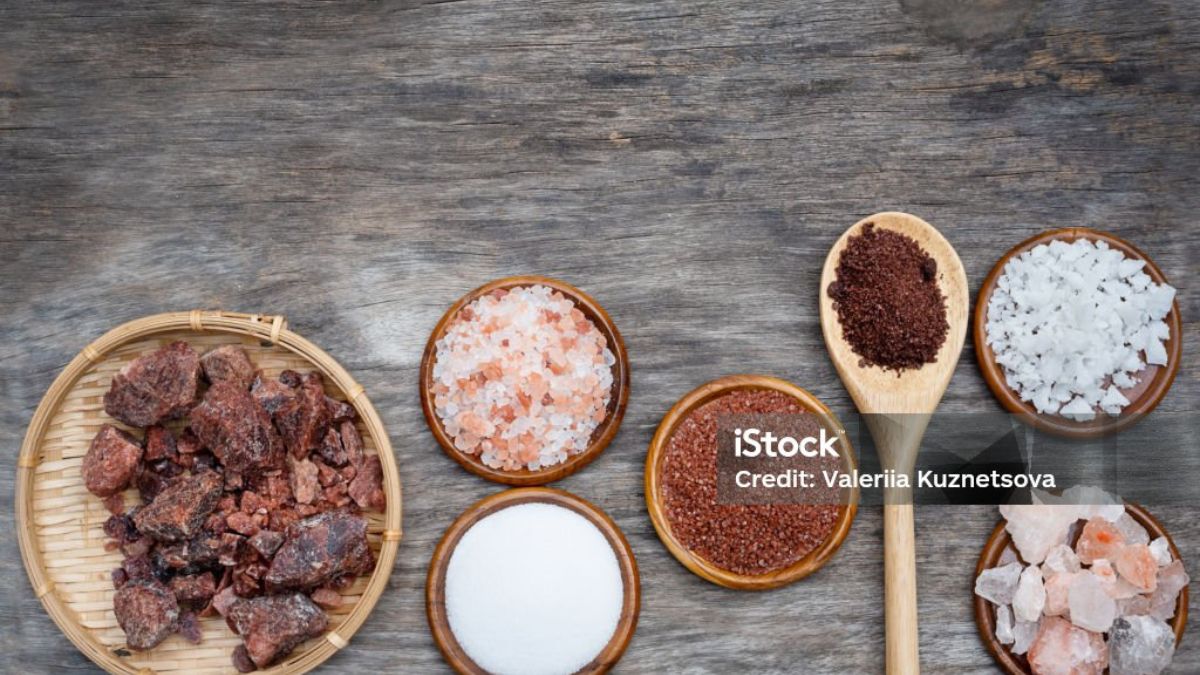HEALTH
The Wonders of Celtic Salt: A Culinary Gem from the Sea

Picture this: a sprinkle of shimmering salt harvested from the pristine waters of Brittany, France. This isn’t just any ordinary seasoning; it’s Celtic Salt, a culinary treasure steeped in history and bursting with flavor. As chefs and home cooks alike seek out ways to elevate their dishes, emerges as a standout choice. Its unique texture and mineral-rich profile not only enhance the taste but also offer numerous health benefits. Join us on an exploration into the world of Celtic Salt—a journey through its origins, uses, and reasons why you should make room for this gem in your kitchen pantry.
The History and Origin of Celtic Salt
Celtic salt has a rich heritage that traces back to ancient times. Its origins are deeply rooted in the coastal areas of France, particularly Brittany. Here, traditional harvesting methods have been passed down through generations.
Salt workers known as “paludiers” utilize wooden tools to gather this prized mineral from tidal marshes. These techniques respect the natural environment and allow for minimal processing, preserving the salt’s unique characteristics.
The distinct gray color of comes from its high mineral content. This is due to its contact with clay during evaporation processes. As a result, it boasts not just flavor but also nutritional value.
Historically, Celtic salt was seen as more than just seasoning; it held medicinal properties and played a crucial role in trade among various cultures. Its allure spans centuries, making it a treasured culinary gem today.
Nutritional Benefits of Celtic Salt
Celtic salt is more than just a seasoning; it’s packed with essential minerals. Harvested from the pristine waters of the Atlantic, this natural salt retains vital trace elements that are often stripped away in regular table salt.
It contains magnesium, calcium, and potassium—minerals crucial for hydration and nerve function. These nutrients can support muscle health and help maintain electrolyte balance in the body.
Additionally, boasts lower sodium content compared to traditional salts. This quality makes it a heart-friendly option for those watching their sodium intake.
The unique moisture content of Celtic salt allows it to dissolve easily on food, enhancing flavor without overwhelming your palate. Its rich mineral profile not only elevates dishes but also contributes positively to overall wellness.
Incorporating this culinary gem into your diet can be as beneficial as it is delightful.
How is Celtic Salt Different from Regular Table Salt?
Celtic salt stands apart from regular table salt in several ways. One of the most notable differences is its harvesting process. is hand-harvested from coastal regions, particularly in France, using traditional methods that preserve its natural minerals.
Regular table salt, on the other hand, often undergoes heavy processing. This includes refining and bleaching that strip away beneficial elements. As a result, it typically contains additives like anti-caking agents.
The mineral content also sets these salts apart. Celtic salt retains essential trace minerals such as magnesium and potassium which contribute to its unique flavor profile and health benefits.
In terms of texture, has a coarser grain compared to the fine granules found in table salt. This not only affects how it dissolves but also enhances its ability to elevate dishes through crunchiness and visual appeal.
Whether you’re cooking or seasoning at the table, choosing between them can influence both taste and nutrition significantly.
Culinary Uses of Celtic Salt
Celtic salt is more than just a seasoning; it’s a flavorful enhancer that brings dishes to life. Its coarse texture adds a delightful crunch, making it perfect for finishing touches on grilled meats or roasted vegetables.
When cooking soups and stews, this salt dissolves beautifully, infusing the entire dish with its rich flavor profile. Try using in your marinades for an extra layer of taste that elevates even the simplest ingredients.
Bakers often appreciate its unique ability to balance sweet flavors. A sprinkle of atop cookies or caramel desserts can create an irresistible contrast that delights the palate.
Don’t forget about salads! Incorporating Celtic salt into dressings enhances freshness while adding depth. It harmonizes brilliantly with olive oil and vinegar, transforming ordinary greens into extraordinary meals.
Other Surprising Uses for Celtic Salt
Celtic salt isn’t just for seasoning your favorite dishes. It holds a variety of surprising uses that can enhance everyday life.
You can use it in beauty routines. A pinch of in your bathwater adds minerals and helps soothe tired muscles. It’s a natural exfoliant, too, perfect for DIY scrubs to rejuvenate your skin.
Household cleaning is another area where this sea gem shines. Mix with lemon juice to create an effective scrub for kitchen surfaces and cutting boards, leaving them sparkling clean.
Gardeners appreciate its role in pest control. Sprinkling some around plants may deter unwanted insects without harming the environment.
Consider using Celtic salt as part of aromatherapy practices. Adding a few crystals to essential oil blends can amplify their benefits and create a calming atmosphere in any space.
Where to Find and How to Use Authentic Celtic Salt
Finding authentic Celtic salt can be an adventure in itself. Look for specialty food stores, health shops, or local farmers’ markets that focus on natural products. Online retailers also offer options from reputable brands.
When purchasing, check the packaging for authenticity. Genuine should have a grayish hue and a moist texture, indicating its mineral-rich content.
Using Celtic salt in your kitchen is quite simple. Sprinkle it over vegetables before roasting to enhance flavor and nutrients. It works wonderfully as a finishing touch on grilled meats or fish too.
For those daring enough to experiment, try adding it to baked goods like breads or cookies for an unexpected twist. Remember that less is more; its strong taste means you won’t need much compared to regular table salt.
Conclusion
Celtic Salt stands out as more than just a seasoning; it’s a treasure from the sea that enriches both flavor and health. With its deep-rooted history and unique harvesting methods, this natural salt offers an array of nutritional benefits that many overlook. Unlike regular table salt, retains essential minerals and boasts a distinctive taste profile that elevates dishes to new heights.
Its culinary versatility is impressive. Whether you’re sprinkling it on fresh vegetables or using it in baking, enhances flavors without overpowering them. Beyond the kitchen, its surprising uses in beauty regimens and wellness practices make it an all-around gem.
If you’re looking to incorporate this exquisite ingredient into your life, seek out authentic sources for the best quality. The journey into exploring Celtic Salt can transform your cooking experience while benefiting your overall well-being.
Embracing Celtic Salt is about appreciating tradition while enhancing modern culinary arts. It’s time to savor every grain!
HEALTH
Ancient Places You Must Visit: A Traveler’s Guide to Historic Wonders

Introduction to Ancient Places
Traveling to ancient places is like stepping into a time machine. These historic wonders transport you back to eras filled with mystery, ingenuity, and breath taking beauty. Each site tells a story—a narrative of civilizations that once thrived and shaped our world. From awe-inspiring pyramids to grand temples, these destinations are not just remnants of the past; they offer invaluable insights into human creativity and resilience.
Exploring ancient sites sparks curiosity and ignites wanderlust in every traveller. Whether you’re an archaeology enthusiast or simply seeking adventures steeped in history, there’s something magical about standing where others stood centuries ago. Imagine walking through stories carved in stone as you connect with the echoes of those who came before us.
Ready for an unforgettable journey? Let’s dive into some must-visit ancient places that promise to leave you spellbound!
The Mysteries and Fascination of Ancient Wonders
Ancient wonders hold a magnetic allure. They are remnants of civilizations long past, each whispering stories that echo through time. The craftsmanship and ingenuity behind these structures often leave us in awe.
Consider the precision of the Great Pyramid of Giza. Built over 4,500 years ago, it continues to baffle architects and historians alike. How did ancient Egyptians achieve such remarkable feats without modern technology?
Then there’s Stonehenge, an enigma wrapped in mystery. Its purpose remains debated among scholars—was it astronomical observatory or a spiritual site? The unanswered questions only deepen our fascination.
Every ancient place invites exploration and ignites curiosity about humanity’s origins. These sites remind us of our shared heritage and spark imagination as we ponder what life was like when they were first constructed. Each visit is an opportunity to connect with history on a profound level.
Top 5 Ancient Places You Must Visit
When it comes to ancient places, few can match the allure of Egypt. The Pyramids of Giza stand tall, mesmerizing visitors with their grandeur and mystery. Each stone tells a story from an era long gone.
Next is Greece, where history breathes through its ruins. Athens boasts the Acropolis, a symbol of democracy and culture. Wander among marble columns that have witnessed centuries unfold.
Peru offers Machu Picchu, an Incan citadel perched in the Andes. Its breath taking views and intricate terraces are unforgettable treasures waiting to be explored.
Cambodia’s Angkor Wat reveals stunning architecture surrounded by lush jungles. This temple complex reflects an ancient civilization’s devotion to spirituality and artistry.
Italy enchants with Pompeii’s preserved remnants after volcanic fury buried it for centuries. Walking these streets feels like stepping back into time itself—an experience unlike any other.
Egypt: The Land of Pharaohs and Pyramids
Egypt stands as a timeless symbol of grandeur and mystery. The iconic pyramids, towering above the desert sands, evoke awe in every traveller. These ancient monuments are not just structures; they’re eternal stories etched into stone.
Exploring the Pyramid of Giza is like stepping back into history. Imagine walking among these colossal tombs that once housed pharaohs, guardians of an age long past. Each stone tells tales of ambition and divine connection.
Beyond the pyramids, the Sphinx watches over visitors with its enigmatic gaze. It’s a reminder of Egypt’s rich mythology and intricate craftsmanship.
Cruising down the Nile offers another perspective on this magnificent land. The river has nurtured civilization for millennia, making it an essential part of Egyptian heritage.
Every corner holds secrets waiting to be uncovered—ancient temples adorned with hieroglyphics whispering stories from centuries ago. Egypt invites you to delve deep into its fascinating past while marvelling at its enduring beauty.
Greece: Home to the Birthplace of Western Civilization
Greece stands as a testament to the brilliance of ancient culture. This enchanting country is often hailed as the birthplace of Western civilization. Its rich history unfolds through stunning landscapes, from sun-kissed islands to rugged mountains.
Athens, the capital city, boasts iconic structures like the Parthenon. This temple dedicated to Athena showcases breath taking architecture and artistry that continue to inspire today’s designers.
Delve into mythology at places such as Delphi and Olympia. These sites whisper tales of gods and heroes who shaped human thought for centuries.
The allure doesn’t stop with ruins. Traditional tavernas serve mouth watering dishes steeped in flavours from ancient recipes, connecting visitors with Greece’s culinary roots.
Wander along cobblestone streets where philosophers once debated profound ideas. Each corner reveals layers of history waiting to be explored in this timeless land that still captivates travellers from all walks of life.
Peru: Discovering the Incan Empire at Machu Picchu
Perched high in the Andes, Machu Picchu is a testament to the ingenuity of the Incan Empire. Its breath taking views and remarkable architecture captivate every visitor.
The journey begins with a scenic train ride or an adventurous trek along the Inca Trail. Each step reveals stunning vistas that leave you in awe of nature’s beauty.
As you wander through ancient stone structures, it’s easy to imagine life during its heyday. The precise construction techniques used by the Incas are still a source of wonder today.
Don’t miss the Intihuatana stone, often referred to as the “Hitching Post of the Sun.” This ritualistic stone played a crucial role in agricultural practices and spiritual beliefs.
Every corner tells a story—be it from temples dedicated to gods or terraces once used for farming. Machu Picchu isn’t just a destination; it’s an experience that connects you with history itself.
Cambodia: Exploring the Temples of Angkor Wat
Cambodia’s crown jewel, Angkor Wat, is a breath taking testament to the ingenuity of the Khmer Empire. Spanning over 162 hectares, this temple complex invites you to wander through its intricate carvings and sprawling courtyards.
As dawn breaks, the silhouette of Angkor Wat reflects on the surrounding moat. This magical sight draws countless photographers eager to capture its beauty. The detailed bas-reliefs tell stories of ancient myths and battles, showcasing a rich tapestry of culture.
Exploring beyond Angkor Wat leads you to Ta Prohm. Here, massive tree roots intertwine with crumbling stone structures, creating an enchanting atmosphere frozen in time.
The air is thick with history as you traverse these sacred grounds. Each step reveals layers of artistry and devotion that have endured for centuries, making it a truly unforgettable experience for any traveller seeking connection with the past.
Italy: Journey Through the Ruins of Pompeii
Italy offers a captivating glimpse into the past with its archaeological marvels. Pompeii is perhaps one of the most intriguing ancient places you can explore. Once a thriving Roman city, it was buried under volcanic ash from Mount Vesuvius in 79 AD, preserving it for centuries.
As you stroll through the cobbled streets, you’ll encounter well-preserved ruins that tell stories of everyday life in ancient Rome. From homes adorned with frescoes to bustling marketplaces, every corner reveals a piece of history waiting to be uncovered. The haunting silence around these structures evokes a sense of wonder and reflection.
Visiting Pompeii allows you to step back in time and immerse yourself in an extraordinary civilization that thrived long ago. It’s more than just ruins; it’s an emotional journey through resilience and tragedy, where nature’s power met human creativity.
Each site we’ve discussed showcases unique aspects of ancient civilizations that continue to inspire travellers today. These historic wonders beckon adventurers from all walks of life eager to connect with our shared past. Whether you’re wandering through Egypt’s pyramids or standing amidst the grandeur of Angkor Wat, each ancient place holds secrets ready to be discovered by those willing to seek them out.
HEALTH
Wordle Challenges: Creative Ways to Spice Up Your Daily Puzzle

Introduction to Wordle and its popularity
Wordle has taken the world by storm, captivating word enthusiasts and casual players alike. Each day, millions of people eagerly anticipate their next five-letter puzzle challenge. The thrill of solving the mystery in just six guesses is both exhilarating and rewarding. But what if you could elevate your daily Wordle experience? Enter “Wordle Challenges.” These creative twists offer fresh perspectives on this beloved game, transforming it from a solo sprint into an exciting adventure filled with surprises and strategies. Whether you’re looking to enhance your skills or enjoy some friendly competition, there’s a whole new layer of fun waiting for you to explore!
The Benefits of Playing Wordle Challenges
Wordle challenges offer a fun way to sharpen your brain. Engaging with daily puzzles enhance cognitive skills like problem-solving and critical thinking. Each guess requires strategy, pushing players to think several steps ahead.
Additionally, they foster creativity. When faced with tricky words, players often come up with unique solutions or clever associations that expand their vocabulary. This game isn’t just about winning; it’s about exploring the depths of language in an entertaining format.
Playing alongside friends can also boost social connections. Sharing strategies and celebrating victories together adds layers of enjoyment to the experience. It transforms solitary gameplay into a collaborative adventure, making each challenge more memorable.
Moreover, Wordle challenges can be stress-relieving. Immersing yourself in wordplay allows for a brief escape from daily worries while stimulating mental agility at the same time. With every puzzle solved, you gain a sense of accomplishment that brightens your day.
Creative Ways to Play Wordle: Solo vs. Multiplayer
Wordle is often enjoyed solo, but there are exciting multiplayer options that can elevate your experience. Playing alone allows for personal reflection and skill sharpening. It’s your own journey to solve the puzzle at your pace.
However, invite friends or family into the mix, and the game transforms into a lively competition. You can share your guesses in real-time, engaging in friendly banter as you race against each other. This interaction adds an extra layer of excitement.
Another twist? Set up team challenges where players collaborate to guess words together within a time limit. Working as a unit not only strengthens bonds but also enhances collective problem-solving skills.
Consider creating themed Wordle nights with specific categories like movies or animals. This variation keeps everyone on their toes while adding an intellectual challenge that spices things up immensely.
Incorporating Themes and Categories into your Wordle Game
Adding themes and categories to your Wordle game can elevate the experience. Instead of random words, choose a specific topic like animals, movies, or historical figures. This not only makes guessing more engaging but also educates players on various subjects.
You can create themed Wordle challenges for different occasions too. Consider holiday-themed words during festive seasons or vocabulary from recent movies in summer. It’s a creative way to keep the game fresh.
Playing with friends? Try assigning each player a category and see who guesses their themed word first. This adds an element of competition while fostering camaraderie among participants.
For those who love variety, switch up themes daily or weekly. You could even invite friends to suggest new categories for future games—making it collaborative and fun! Themes breathe new life into traditional gameplay and provide endless opportunities for creativity.
Using Time Limits and Scoring Systems for an Added Challenge
Adding time limits to your Wordle challenges can elevate the excitement. Try setting a timer for three minutes. This creates urgency and tests your quick thinking.
You might also consider introducing a scoring system. Assign points based on how many guesses you take. For instance, award five points for getting it in one try, four for two tries, and so on. At the end of the week, tally up scores with friends or family.
This competitive edge enhances engagement and pushes everyone to improve their skills. It turns casual play into an exhilarating race against both time and each other’s scores.
Consider integrating bonus rounds where players earn extra points by guessing themed words quickly. These twists not only keep things fresh but also make every session feel unique and rewarding.
Tips and Tricks for Improving Your Wordle Skills
To elevate your Wordle game, start with vowel-rich words. Using terms like “audio” or “crate” can quickly reveal valuable letters.
Next, pay attention to letter frequency in the English language. Common consonants such as R, S, and T will often lead you toward the correct answer faster.
Don’t rush through your guesses. Take a moment to think about the feedback from previous attempts; it’s crucial for narrowing down possibilities.
Try using different starting words each day. This keeps things fresh and challenges your brain to adapt its strategy.
Practice makes perfect! Engage with similar word puzzles outside of Wordle to sharpen your skills further and expand your vocabulary.
Conclusion: Why You Should Give Wordle Challenges a Try
Wordle challenges offer a fresh twist on an already beloved game. By adding creative elements and themes, you can keep the experience engaging and fun. Whether you’re playing solo or with friends, there are countless ways to elevate your daily puzzle routine.
Incorporating time limits and scoring systems introduces competition and excitement. This not only sharpens your skills but also makes each session more thrilling. Plus, exploring different themes can add a layer of creativity that keeps players coming back for more.
If you’re looking to improve your Wordle abilities, remember to practice regularly. Experimenting with various strategies will help enhance your vocabulary and problem-solving skills over time.
Embracing Wordle challenges opens up new avenues for enjoyment while keeping the spirit of the original game alive. So why not give it a try? Dive into these variations today and discover how much fun word puzzles can truly be!
HEALTH
Kneib Dentistry: discovery a new Standard in Oral Care

Introduction to Kneib Dentistry
Welcome to the world of Kneib Dentistry, where your oral health takes centre stage. Imagine a dental experience that feels less like a chore and more like a personalized journey toward your best smile. At Kneib Dentistry, we believe that exceptional care starts with understanding each individual patient’s needs. Whether you’re anxious about your next visit or simply seeking a new standard in oral care, this is the place for you. Join us as we explore the history, innovative techniques, and heartfelt stories that make Kneib Dentistry stand out from the crowd. Your path to optimal dental health begins here!
History and Philosophy of Kneib Dentistry
Kneib Dentistry has a rich history rooted in a commitment to exceptional oral care. Established by Dr. Kneib, the practice has grown from humble beginnings into a trusted dental home for many families.
The philosophy here centres around patient-cantered care. Every individual is treated as more than just a number; each patient’s needs and concerns are prioritized.
Education plays an integral role in their approach. The team believes that informed patients make better decisions about their oral health.
From preventive measures to advanced treatments, the focus remains on holistic well-being. Each step of the dental journey is designed to foster comfort and trust, ensuring patients feel valued and understood.
This foundation not only reflects respect for tradition but also embraces modern advancements in dentistry, creating a unique blend that sets Kneib Dentistry apart in the field of oral care.
Innovative Techniques and Technology Used by Kneib Dentistry
Kneib Dentistry is at the forefront of dental innovation. The clinic utilizes cutting-edge technology to enhance patient care and comfort.
One standout feature is their use of digital imaging. This technique allows for precise diagnostics while minimizing radiation exposure. Patients can see a detailed view of their oral health in real-time.
Another impressive tool is the CEREC system, which enables same-day crowns. Gone are the days of multiple visits and temporary fittings. With this technology, patients leave with permanent restorations within hours.
Laser dentistry also plays a significant role in treatment plans here. It provides a less invasive option for procedures like gum reshaping or cavity removal, resulting in quicker recovery times.
These innovations reflect Kneib Dentistry’s commitment to excellence and patient satisfaction, ensuring that each visit is as efficient as it is comfortable.
Personalized Treatment Plans for Patients
At Kneib Dentistry, every patient is treated as an individual with unique needs. This philosophy drives the creation of tailored treatment plans designed specifically for each person.
During your initial consultation, a comprehensive assessment takes place. The team evaluates not just your oral health but also your lifestyle and preferences. This holistic approach ensures that recommendations align with what you value most in dental care.
Whether it’s preventive measures or cosmetic enhancements, personalized treatments focus on achieving optimal results while keeping comfort at the forefront. You can expect open communication throughout the process to address any concerns.
The goal is to build lasting relationships based on trust and understanding. With Kneib Dentistry, your journey towards better oral health becomes a collaborative effort between you and skilled professionals dedicated to making a difference in your life.
Patient Testimonials and Success Stories
At Kneib Dentistry, patient experiences speak volumes. Many individuals have shared stories of transformation and relief after their visits. These testimonials highlight the compassionate care provided by the team.
One patient expressed gratitude for a pain-free experience during an extensive procedure that once seemed daunting. The gentle approach made all the difference in easing anxiety.
Another success story features a young mother who found her child’s fear of dental visits dissipating due to the friendly atmosphere and engaging staff. The child’s smile has flourished ever since.
Patients often mention how personalized treatment plans tailored to their specific needs enhance their overall well-being. They appreciate being active participants in their oral health journey.
These heartfelt accounts showcase not just improved smiles but also renewed confidence and trust in dental care, making every visit memorable for patients at Kneib Dentistry.
The Importance of Regular Dental Check-ups
Regular dental check-ups are vital for maintaining optimal oral health. These visits allow dentists to identify potential issues before they escalate into serious problems. Early detection can save you time, money, and unnecessary discomfort.
During a routine examination, your dentist will assess not only your teeth but also your gums and overall mouth health. This comprehensive approach ensures that any signs of decay or disease are addressed promptly.
Preventive care is another key benefit of regular visits. Professional cleanings remove plaque buildup that brushing alone may miss. This helps prevent cavities and gum disease, promoting healthier smiles.
Moreover, consistent appointments foster a trusting relationship between patients and their dental team. Comfort in discussing concerns becomes easier when you know your dentist understands your history and preferences.
Prioritizing these check-ups contributes to long-term well-being while keeping your smile bright and healthy.
Conclusion: Experience the Difference at Kneib Dentistry
When you choose Kneib Dentistry, you’re not just selecting a dental practice; you’re embracing a new standard in oral care. The combination of innovative techniques and personalized treatment plans sets them apart from the rest. Patients are treated like family, ensuring that each visit is comfortable and tailored to individual needs.
Regular dental check-ups at Kneib Dentistry go beyond routine cleanings—they’re about maintaining your overall health. With advanced technology and skilled professionals, every appointment becomes an opportunity for better health outcomes.
Experience the difference that dedicated care can make in your life. Whether you need a simple cleaning or more complex procedures, Kneib Dentistry stands ready to meet your needs with expertise and compassion. Your smile deserves this level of attention and professionalism—visit Kneib Dentistry today!
-

 TOPIC6 months ago
TOPIC6 months agoExploring the Significance of L484: What You Need to Know
-

 TOPIC5 months ago
TOPIC5 months agoSocceragency.net Contact Address Brad Barkshaw: Overview
-

 HEALTH5 months ago
HEALTH5 months agoA Journey Through celebrating chilaquiles : Exploring Regional Variations and Festive Recipes
-

 TECHNOLOGY6 months ago
TECHNOLOGY6 months agoThe Power i’m feeling curious : Exploring New Ideas and Perspectives
-

 BUSINESS6 months ago
BUSINESS6 months agoUnlocking Speed: A Comprehensive Review of SpeedyShort.com
-

 HEALTH6 months ago
HEALTH6 months agoThe Ultimate Guide to pizza edition: From Neapolitan to New York Slice
-

 TECHNOLOGY6 months ago
TECHNOLOGY6 months agoExploring the Best online mac Resources for Mac Users: A Comprehensive Guide
-

 TOPIC5 months ago
TOPIC5 months agoExploring the Universe of Katz Martian: A Deep Dive into His Creative World
